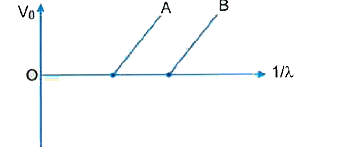Figure shows the stopping potential (V0) for the photo electron vers (1λ) graph, for two metals A and B, λ being the wavelength of incident light.

If the distance between the light source and the surface of metal A is increased, how will the stopping potential for the electrons emitted from it be affected ? Justify your answer.
Stopping potential remains unchanged because it solely depends on the frequency (or wave length) of incident radiation and is independent of all other factors.
Topper's Solved these Questions
- CBSE EXAMINATION PAPER 2020 (SOLVED)BOOK - U-LIKE SERIESCHAPTER - CBSE EXAMINATION PAPER 2020 (SOLVED)EXERCISE - SECTION C
11 Videos
- CBSE EXAMINATION PAPER 2020 (SOLVED)BOOK - U-LIKE SERIESCHAPTER - CBSE EXAMINATION PAPER 2020 (SOLVED)EXERCISE - SECTION D
11 Videos
- CBSE EXAMINATION PAPER 2020 (SOLVED)BOOK - U-LIKE SERIESCHAPTER - CBSE EXAMINATION PAPER 2020 (SOLVED)EXERCISE - SECTION D
11 Videos
- CBSE EXAMINATION PAPER 2020 BOOK - U-LIKE SERIESCHAPTER - CBSE EXAMINATION PAPER 2020 EXERCISE - SECTION D
12 Videos
- CBSE EXAMINATION PAPER 2020 (SOLVED) BOOK - U-LIKE SERIESCHAPTER - CBSE EXAMINATION PAPER 2020 (SOLVED) EXERCISE - SECTION - D
6 Videos
Similar Questions
Figure shows the stopping potential (V0) for the photo electron vers (1λ) graph, for two metals A and B, λ being the wavelength of incident light.

How is the value of Planck's constant determined from the graph ?
View SolutionThe following graph shows the variation of stopping potential V0 with the frequency v of the incident radiation for two photosensitive metals X and Y.
(i) Which metal has larger threshold wavelength ? Give reason.
(ii) Explain giving reason , which metal gives out electrons , having larger kinetic energy , for same wavelength of the incident radiation.
(iii) If the distance between the light source and metal X is halved , how will the kinetic energy of electrons emitted from it change ? Given reason.

View Solution
Knowledge Check
The stopping potential are V1 and V2. Calculate the (V1−V2), if the λ1 and λ2 are wavelength of incident lights, respectively.
Ahce(1λ1−1λ2)Bhce(1λ1+1λ1)Cehc(1λ1+1λ2)Dehc(1λ1−1λ2)When light of wavelenght λ incident on a metal then stopping potential is 10V. If wavelengt is increase to 3λ then stopping potential is 2V . Which of the following can emit electron form the metal : -
A5λB7λC9λD10λWhen light of wavelength λ is incident on photosensitive surface, the stopping potential is V. When light of wavelength 3λ is incident on same surface, the stopping potential is V6Thereshould wave length for the surface is
A2λB3λC4λD5λ
When light of wavelength λ is incident on photosensitive surface, the stopping potential is V. When light of wavelength 3λ is incident on same surface, the stopping potential is V6 Threshold wavelength for the surface is
View SolutionThe figure shows the variation of stopping potential VQ with the frequency v of the incident radiations for two photosensitive metals P and
Which metal has smaller threshold wavelength ? Justify your answer.
View SolutionWhen a metalic surface is illuminated with light of wavelength λ, the stopping potential is V. the same surface is illuminated by light of wavelength 2λ the stopping potential is V3 The thershold waelength for the surface is
View Solutiona. A stopping potential of 0.82V is required to stop the emission of photoelectrons from the surface of a metal by light of eavelength 4000A. For light of wavelength 3000A, the stopping potential is 1.85V. Find the value of Planck's constant. [1 electrons volt (eV)=1.6×10−19J]
b. At stopping potential, if the wavelength of the incident light is kept fixed at 4000A, but the intensity of light increases two times, will photoelectric current be botained ? Give reasons for your answer.
View SolutionWhen a metalic surface is illuminated with light of wavelength λ, the stopping potential is V. the same surface is illuminated by light of wavelength 2λ the stopping potential is V3 The thershold waelength for the surface is
View Solution
